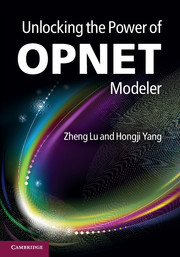Book contents
- Frontmatter
- Contents
- Preface
- List of abbreviations
- Part I Preparation for OPNET Modeling
- Part II Modeling Custom Networks and Protocols
- Part III Modeling and Modifying Standard Networks and Protocols
- 8 Modeling wired networks with standard models
- 9 Modeling wireless networks with standard models
- 10 Modifying standard models
- Part IV OPNET Modeling Facilities
- References
- Index
8 - Modeling wired networks with standard models
from Part III - Modeling and Modifying Standard Networks and Protocols
Published online by Cambridge University Press: 05 February 2012
- Frontmatter
- Contents
- Preface
- List of abbreviations
- Part I Preparation for OPNET Modeling
- Part II Modeling Custom Networks and Protocols
- Part III Modeling and Modifying Standard Networks and Protocols
- 8 Modeling wired networks with standard models
- 9 Modeling wireless networks with standard models
- 10 Modifying standard models
- Part IV OPNET Modeling Facilities
- References
- Index
Summary
This chapter shows how to construct wired networks with standard OPNET models in an evolutionary style. Differently from Chapters 5–7, where custom OPNET models are developed, in this chapter standard OPNET models are discussed. These standard models are pre-created and shipped with the OPNET Modeler. Standard OPNET models include TCP, IP, IPV6, ATM, MPLS, OSPF, TDMA, WiMAX, ZigBee, etc. To follow this chapter, it is preferable to know the basic operations of OPNET Modeler, though not necessary.
The process for simulating standard models is similar to that for simulating custom models as demonstrated in Chapter 5. The following are the steps of simulating standard models:
Create a project via Project Editor.
Create a scenario within this project.
Create a network topology for this scenario by placing the standard models on the Project Editor.
Verify the link connectivity of this network.
Select the statistics in which you are interested.
Run the simulation for this scenario.
View, compare, and analyze statistic results.
If necessary, export statistic data to a spreadsheet for further processing.
In the following sections, case studies on how to model standard wired networks are demonstrated.
Client/server structure
In this section, a simple client/server structure will be created and modeled. The client and server are computers that are connected by links.
- Type
- Chapter
- Information
- Unlocking the Power of OPNET Modeler , pp. 125 - 136Publisher: Cambridge University PressPrint publication year: 2012



